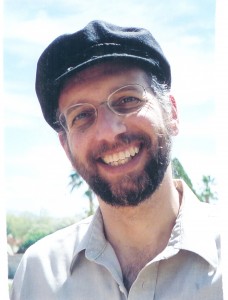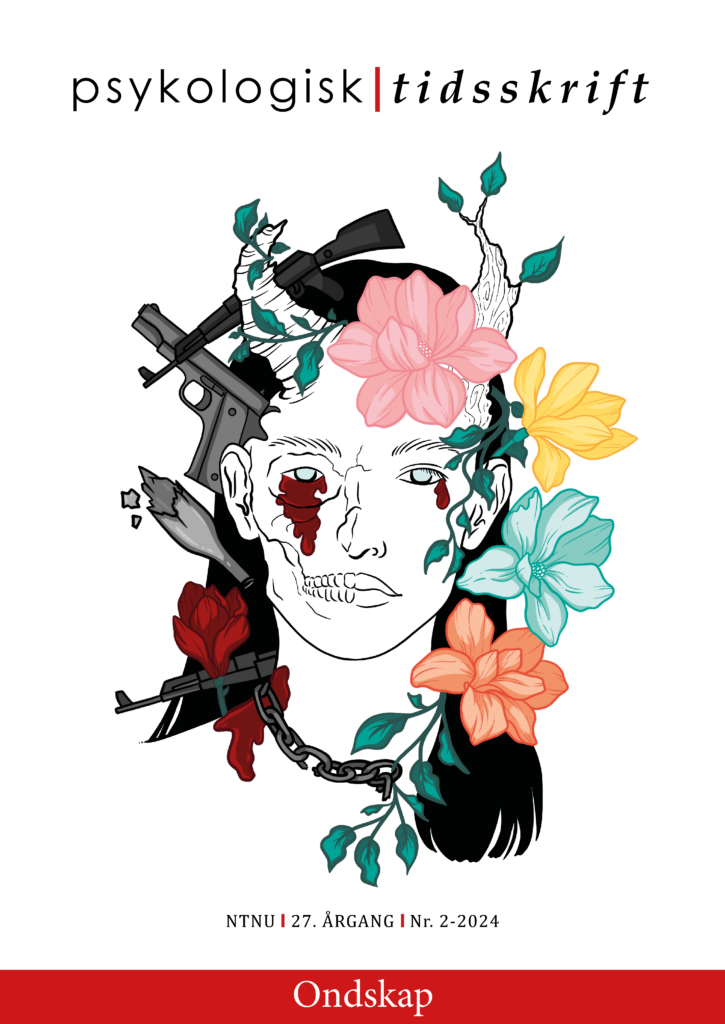Jeff Greenberg, University of Arizona.
Denne teksten er publisert i Psykologisk Tidsskrift NTNU nr. 2-2015 «Stress, risiko og frykt». Interessert i hele utgaven? Gå til vår bestillingsside.
I’m beginning this essay on the sad day I found out Chris Squire, the bass player for my favorite band, Yes, died of Leukemia. Chris was beloved by many musicians and music lovers, including me. There’s no doubt that one of the worst things about being human is knowing that all those you care about, including yourself, are destined to die: And that this can happen at any time, often arbitrarily cutting lives short of expectations. Given that only we humans can fully comprehend these horrible truths, one would hope we would be the last species to add to the toll of premature death otherwise caused by disease, accident, and natural disasters.
Of course the truth is quite the opposite. We kill our own like no other species on the planet. The question then becomes how we can make sense of our penchant for carnage against our own? Most of this carnage is intergroup aggression, acts perpetrated by representatives of one group (tribal, national, political, or religious) against members of another. Most domestic and international aggression we label terrorism can also be viewed as intergroup aggression in that the perpetrator’s intention almost always involves the individual believing he or she is serving some group, real or imagined, and often goaded on or trained by that group (my colleagues and I have applied terror management theory to understanding intergroup aggression and terrorism in numerous publications, e.g., Pyszczynski, Solomon, & Greenberg, 2003; Pyszczynski, et al., 2006; Solomon, Greenberg, & Pyszczynski, 2015). But here I want focus in on the increasingly prevalent events in which individuals take multiple lives on a single day, going berserk so to speak, most often in the context of “school shootings“, although it’s happened in eateries, workplaces, and places of worship as well. What is behind these heinous events, and why are they becoming more and more common?
I’m going to use terror management theory (TMT) to provide some insights in these actions, but first two caveats. First, multiple causal factors play a role in any specific act of human aggression. Greenberg, Schmader, Arndt, & Landau (2015) includes a chapter which provides an up to date overview of the many biological and psychological factors that have been shown to contribute to aggression: Genes, testosterone, disrupted attachment, mental health problems, stressors, social learning, and availability of lethal weapons are among them. Second, every school shooting or other mass shooting is unique in some ways. No individuals or situations are exactly the same. Nonetheless, there are certain common elements across these acts, and TMT sheds some light on them.
TMT begins by nothing our common heritage with other animals, most notably a wide range of biological systems that serve to keep us alive. Like other animals we’re driven toward surviving and react against threats to our continued existence. But we humans are also unique in a couple of psychologically important ways. First we are born the most helpless creatures on the planet: For an extended period, we survive only through the efforts of our caretakers, typically our parents. But we also have a great capacity for learning and language, for thinking of the past and the future, and for being aware of ourselves as beings in the world. These cognitive capacities that grow over the course of development are useful in many ways but also make us acutely aware of how dangerous the world is, how vulnerable we are, and that the only inevitable event in our future is death. Given these realizations, many thinkers over the ages have wondered why we are not all perpetually riddled with anxiety and mired in despair.
Novelist William Faulkner put it this way:
If death be anything at all beyond a brief and peculiar emotional state of the bereaved it must be a brief and likewise peculiar state of the subject as well. And if aught can be more painful to any intelligence above that of a child or an idiot than a slow and gradual confronting with that which over a long period of bewilderment and dread it has been taught to regard as an irrevocable and unplumbable finality, I do not know it. (Faulkner, 1936/1986, p. 141-142).
What allows most of us humans to function with equanimity rather than in a constant state of anxiety and despair is living psychologically embedded in a symbolic conception of reality that convinces us we are significant beings in a meaningful world rather than material creatures whose only certain fate is obliteration upon physical death. Each culture provides such a worldview for its children. As young children we only have to feel loved and protected by our parents to feel safe and secure. If we are good, we are loved and protected: If we are bad we are exposed to threat and danger. That secure feeling that we are good transforms over development into the sense that we are unique and valued beings with names, ancestries and descendants, group identities, professions, and lasting accomplishments. The organism writing this essay may physically perish but Jeff Greenberg, New Yorker, American, social psychologist will live on through his name, his writings, his offspring, New York, America, social psychology, and science.
The more each of us functions day to day as significant beings within this symbolic worldview, the better we can sustain the sense we are something more than vulnerable, fragile, mortal creatures. And this psychological security providing sense of being enduringly significant is buttressed by explicit beliefs in an immortal soul and in the lasting memory and impact of our identities and accomplishments. When death is brought close to mind, we therefore try to strengthen our faith in our worldview and strive harder to live up the values of the worldview that provide us with this sense of significance. A body of empirical evidence, well over 500 studies and growing, has supported this analysis in a wide range of ways (for overviews of this work, see Greenberg, Vail, & Pyszczynski, 2014; Solomon, Greenberg, & Pyszczynski, 2015; a periodically updated list of TMT-related publications can be found at tmt.missouri.edu.). Among the pertinent findings, death reminders increase hostility and aggression toward different others, striving for self-worth, desire for fame, and willingness to die for one’s cherished groups and causes. When the psychological resources of the worldview and self-worth are threatened, death thoughts become more accessible and prevalent: We try to defend these structures and experience anxiety to the extent that we cannot.
What does all this have to do with mass shootings? When we learn about these shooters, in almost all cases we find people who are lacking the secure sense of significance we all rely on so that we don’t fall into terror, panic, and despair. And the shootings for these people serve as ways for them to direct their terror outward, eradicate some perceived evil, and try in desperation to establish that they do matter, that they are significant in some way.
Long before these desperate acts became seemingly monthly events, Erich Fromm noted:
“Sadism is one of the answers to the problem of being born human when better ones are not attainable. The experience of absolute control over another being, of omnipotence as far as he, she, or it is concerned, creates the illusion of transcending limitations of human existence, particularly for one whose real life is deprived of productivity and joy. Sadism has essentially no practical aim; it is not “trivial” but “devotional.” it is the transformation of impotence into the experience of omnipotence: it is the religion of psychic cripples.” (Fromm, 1973, p. 290).
We consistently see in the actions of these killers efforts to make a mark, serve a cause, and establish a legacy. All of us humans try to do this, but the vast majority of us do so within culturally accepted means. Many early twentieth century writers such as Thomas Mann and Otto Rank noted that with the decline of religion, the rise of science, and the spread of knowledge of many different worldviews, it has become increasingly difficult to sustain faith in the cultural worldview in which one has been raised. Others such as Ernest Becker and Sherwood Anderson have observed that large-scale cultures make it increasingly difficult to sustain a sense of personal significance and collective identification. Thus it is likely that here in the twenty-first century, more and more people are struggling with sustaining the critical anxiety buffers of faith in the worldview and their own self-worth.
Many of those who feel like they are failing to do so and who lose hope of doing so in the future, try to self-medicate their anxiety and despair away, seek cults, or other non-mainstream bases of meaning and significance. Faced only with the terror of their time ticking away toward death, others try to kill themselves. Some of these mass shooters seem to be engaged in suicidal acts as well, but instead of going out quietly simply to end their misery, they try to go out in a “blaze of glory”. They are striving for significance through heroically defeating evil: They think they are serving to assert justice, or Aryan supremacy, or representing the meek and downtrodden of the world. And so, to paraphrase Becker (1975), to escape from evil, we humans visit the greatest evil upon each other.
The evidence from news reports and other documentation is there for us to see. Let me just give a few examples here. The 1999 Columbine killers, high school students Dylan Klebold and Eric Harris were key accelerants of the modern wave of mass killings, explicitly admired and studied by a number of the more recent killers. They were alienated from and rejected by their classmates, saw life as meaningless and absurd, were drawn toward Hitler, and set upon avenging themselves in a record setting act of carnage likely influenced in part by their familiarity with the first person shooter video game Doom. They wanted to be remembered as the greatest mass killers ever, only thwarted by their ineptitude with bombs (see e.g., http://criminalminds.wikia.com/wiki/Eric_Harris_and_Dylan_Klebold). The terrific 2002 Michael Moore documentary, Bowling for Columbine, explored societal forces at play, but their desire to assert their power and significance and achieve posthumous fame through their act were clearly the key factors motivating them.
Some eight years later, a socially alienated and ridiculed South Korean immigrant living in Virginia, Seung-Hui Cho admired the Columbine killers and wanted also to strike a blow for the meek and rejected. He wanted to break the record for the most killings in a school shooting. And at Virginia Tech University, he did so. After months of planning, on April 16, 2007, he went to the campus and killed two people. Then he left the campus to mail a video to NBC television, in which he proclaimed himself a heroic martyr standing up for the meek like his heroes Klebold, Harris, and Jesus as well. Then he returned for his record-breaking performance, killing 30 additional people before offing himself (see e.g., Kleinfield, 2007).
 On July 22, 2011, Norway experienced a horrendous mass killing when Anders Behring Breivik killed 77 people and injured hundreds others. Evidence suggests Breivik’s mom was deeply troubled and treated Breivik poorly from birth on: He clearly had disrupted attachment and a very difficult childhood that contributed to an extremely fragile sense of self-worth (Husby & Sørheim, 2011). He was judged by acquaintances as physically imposing and intelligent. While experiencing numerous career and financial failures, he worked on a plan to “save” Norway and Western Europe while demonizing Muslims and the Norwegian Labour Party. He referred to himself as the future regent of Norway, a master of life and death, and a warrior and knight. In other words he was grasping desperately for a sense of significance by, in his own mind, leading a heroic triumph over evil (Husby & Sørheim, 2011).
On July 22, 2011, Norway experienced a horrendous mass killing when Anders Behring Breivik killed 77 people and injured hundreds others. Evidence suggests Breivik’s mom was deeply troubled and treated Breivik poorly from birth on: He clearly had disrupted attachment and a very difficult childhood that contributed to an extremely fragile sense of self-worth (Husby & Sørheim, 2011). He was judged by acquaintances as physically imposing and intelligent. While experiencing numerous career and financial failures, he worked on a plan to “save” Norway and Western Europe while demonizing Muslims and the Norwegian Labour Party. He referred to himself as the future regent of Norway, a master of life and death, and a warrior and knight. In other words he was grasping desperately for a sense of significance by, in his own mind, leading a heroic triumph over evil (Husby & Sørheim, 2011).
The latest mass shooter as of this writing was Dylann Roof, who on June 17, 2015, entered a Charleston, South Carolina church and shot to death nine African-Americans during Bible study. Obsessed with germs, with no job or driver’s license, a failure in school and in his social life, he intended to start a civil war. He posed with symbols of racism and white supremacists, including the Rhodesian and Confederate flags, and “88”, a symbol for “Heil Hitler”.
His website included these quotes: To take a saying from my favorite film,
“Even if my life is worth less than a speck of dirt, I want to use it for the good of society…I have no choice. I am not in the position to, alone, go into the ghetto and fight. I chose Charleston because it is most historic city in my state, and at one time had the highest ratio of blacks to Whites in the country. We have no skinheads, no real KKK, no one doing anything but talking on the internet. Well someone has to have the bravery to take it to the real world, and I guess that has to be me” (see e.g., O’Connor, 2015).
So time and again we see a horribly misguided desire to be heroic and attain significance in socially alienated people who have made no progress with more constructive conventional routes to feeling of value. Commonly added to this mix are problems with anxiety-related disorders, exposure to and familiarity with firearms, and attraction to prior perpetrators of mass violence. What can we do to reduce the occurrence of these incidents? Theoretically it’s simple, practically it may be impossible: Cultures and parents who instill their children with a compelling sense that the world is meaningful and that they can be significant contributors to that world: Helping people come to terms with their mortality such that they value their own lives and those of others all the more because of it: Intervening effectively with young people who show clear signs over time of unresolved anxieties and hostilities; better controlling access to firearms. Each of these prescriptions is very hard to fill due to various political, social, and economic barriers. Yet we should still try to do so better than we currently are.
I will close with a few observations from reading more deeply about these killers. Many of them seem strikingly intelligent, but very fragile and riddled with anxiety and hostility. Yet the people around them, while aware of these problems, often did little about their concerns, and were not vigilant as these individuals prepared their attacks and acquired weapons. In addition, in many of the American cases, the system to check the backgrounds of those seeking to purchase firearms failed to be executed properly.
Finally, I noted a certain pattern regarding their worldviews. My colleagues and I have made a distinction between rock type worldviews and hard place worldviews (Pyszczynski, Solomon, & Greenberg, 2003). The rock worldview is one of great certainty regarding heroism and death transcendence, where anger is the prominent negative emotion and a heroic triumph over evil is a central focus. Nationalism, political and religious fundamentalism, prejudice, and pro-military attitudes are common features of such worldviews. The hard place worldview is more relativistic. Right and wrong, good and evil are not so clear. It’s not so easy to know how to feel significant, so anxiety is more prevalent. Self-medicating through drugs, hedonism, and consumerism is common. But most of those inhabiting such worldviews find ways to contribute constructively to the world as they personally understand it. One way to look at many of these killers’ biographies is that the individuals are mired early on in hard place worldviews and struggle to find path toward psychological security within them. So they gravitate over time toward fringe, counter-cultural rock type worldviews in which they can heroically, tragically strike out at the evils they perceive to attain a sense of having a lasting impact on the world.
References:
http://criminalminds.wikia.com/wiki/Eric_Harris_and_Dylan_Klebold
Faulkner, W. (1936/1986). Absalom, Absalom! New York: Vintage Books.
Greenberg, J., Schmader, T., Arndt, J., & Landau, M.J. (2015). Social psychology: The science of everyday life. New York: Worth Publishers.
Greenberg, J., Vail, K., & Pyszczynski, T. (2014). Terror management theory and research: How the desire for death transcendence drives our strivings for meaning and significance. Advances in Motivation Science, 1, 86-134.
Husby, T. & Sørheim, S. (2011). Retrieved from https://sites.google.com/site/breivikreport/documents/anders-breivik-psychiatric-report-of-2011.
Kleinfield, N.R. (2007). Retrieved from http://www.nytimes.com/2007/04/22/us/22vatech.html?pagewanted=all.
O’Connor, B. (2015.) Retrieved from http://gawker.com/here-is-what-appears-to-be-dylann- roofs-racist-manifest-1712767241.
Pyszczynski, T., Abdollahi, A., Solomon, S., Greenberg, J.,Cohen, F., & Weise, D. (2006). Mortality salience, martyrdom, and military might: The Great Satan versus the Axis of Evil. Personality and Social Psychology Bulletin, 32, 525-537.
Pyszczynski, T., Solomon, S., & Greenberg, J. (2003). In the wake of 9/11: The psychology of terror. Washington, D.C.: American Psychological Association.
Solomon, S., Greenberg, J., & Pyszczynski, T. (2015). The worm at the core: On the role of death in life. New York: Random House.


